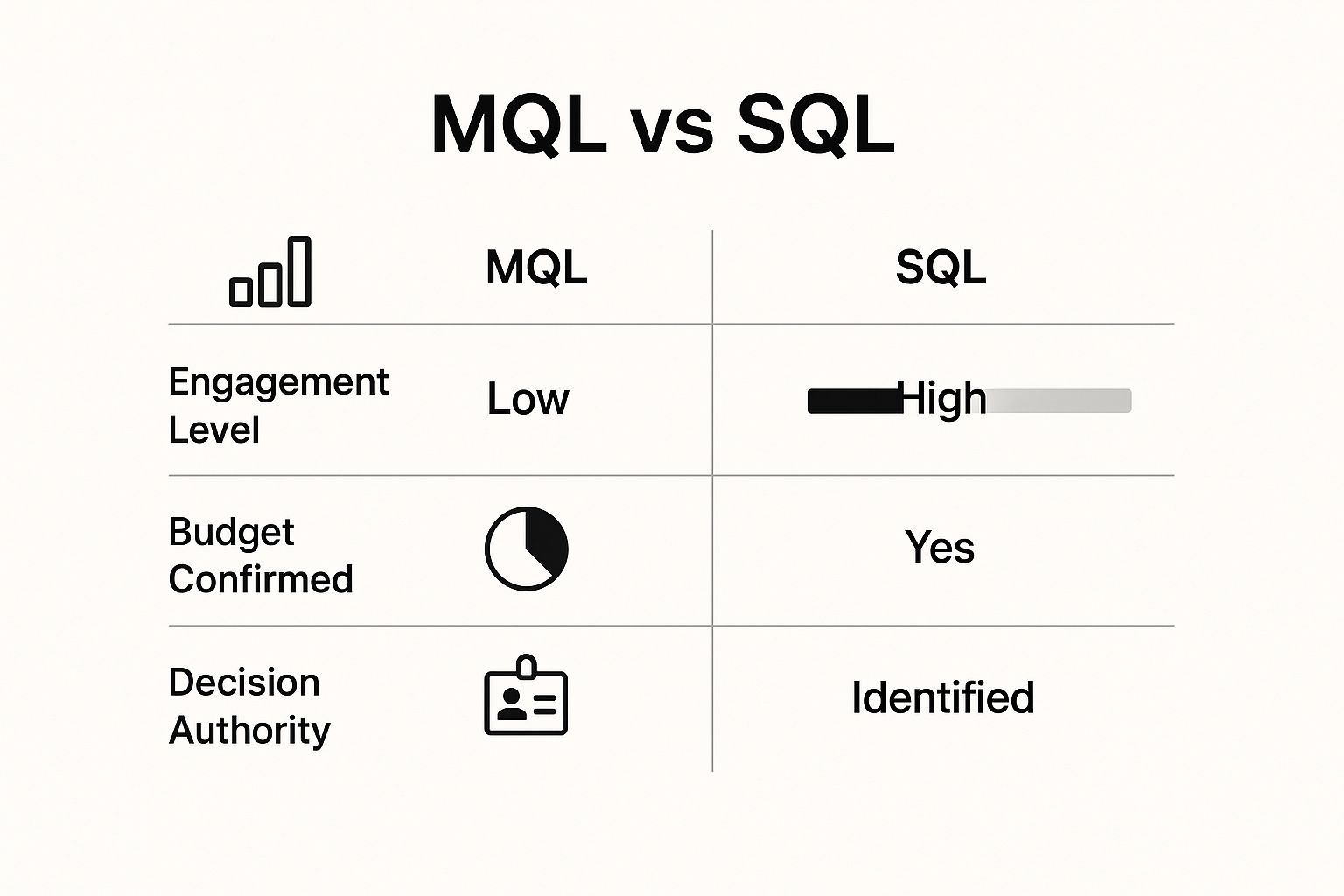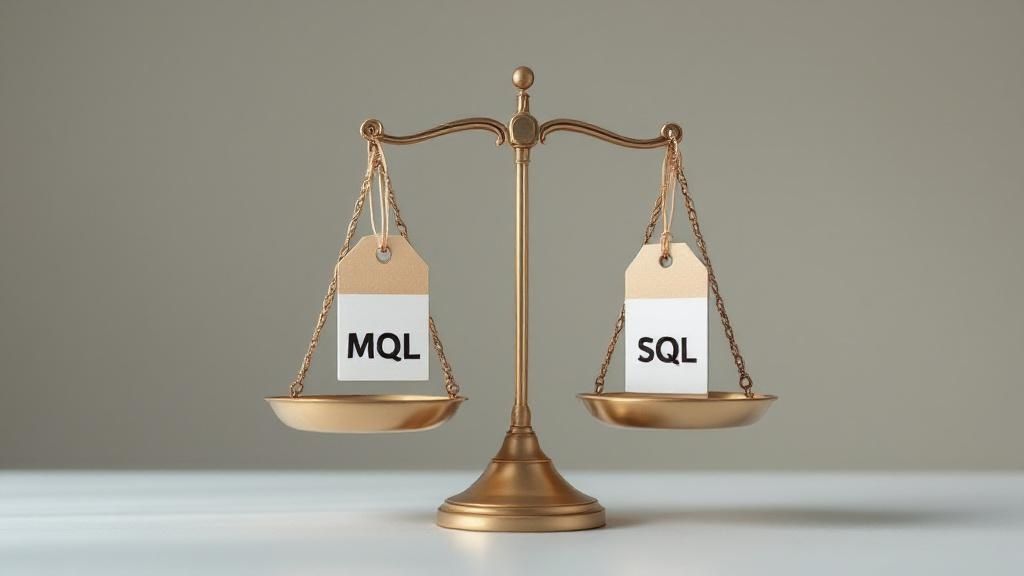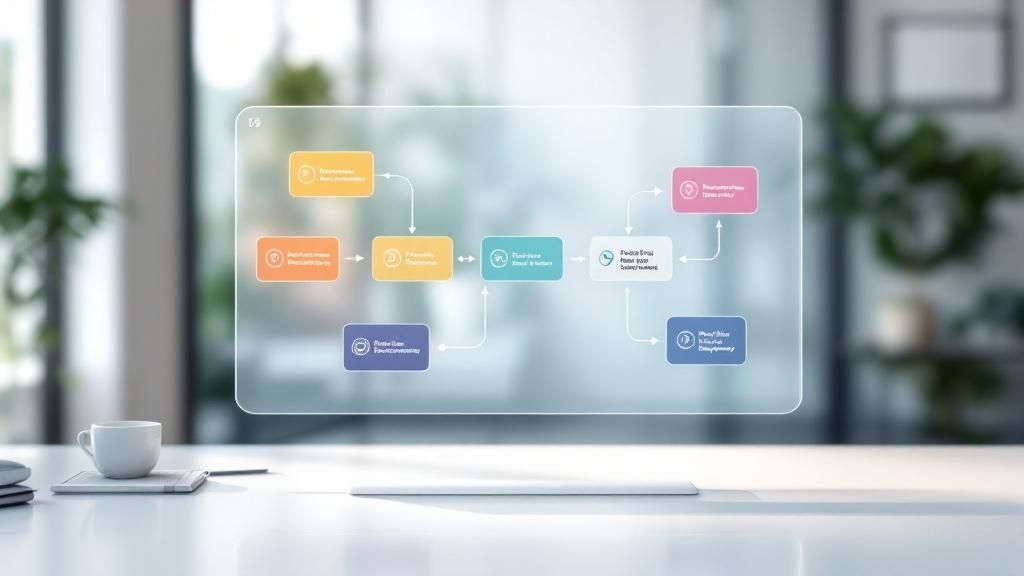So, what exactly is a Sales Qualified Lead (SQL)?
Think of it less like a simple contact in your CRM and more like a conversation-ready prospect who's basically given you the green light for a direct sales call. It's a person who has been checked out by both your marketing and sales teams and is officially deemed ready for the next step.
Understanding the Sales Qualified Lead

Picture your sales funnel as a series of gates. An SQL is someone who has already passed through the initial marketing gates and is now standing right in front of the sales gate, ready to talk. They've moved past just kicking the tires and are now seriously looking at solutions for a problem your business can solve.
This handoff from marketing to sales is a make-or-break moment for any growing company. When done right, it makes sure your sales team's precious time is spent on people who have shown real buying intent, not on those who are still just browsing. Nailing this definition is key to avoiding wasted effort and speeding up your entire sales cycle.
Core Characteristics of an SQL
So, what really separates an SQL from any other lead? It boils down to a few key traits that signal a high chance of becoming a customer. The sales team usually confirms these details through a quick call or by looking at the data marketing has gathered.
A genuine SQL will almost always have:
- An Identified Need: The prospect has a clear, acknowledged pain point or business challenge that you can actually help with.
- Buying Intent: They’ve taken specific actions that scream "I'm ready to decide," like requesting a demo, asking about pricing, or firing up a free trial.
- The Right Profile: The lead fits your ideal customer profile (ICP). Think company size, industry, location, or other key details that make them a good match for you.
This whole vetting process is precisely what makes an SQL so valuable. It represents that critical point where a prospect is ready for a real sales conversation. In fact, leads that get the SQL stamp of approval are far more likely to convert—some studies suggest they're three to five times more likely to become paying customers than earlier-stage leads. For a deeper dive into how SQLs impact conversion rates, you can find some great insights over on Piwik.pro.
Key Takeaway: An SQL isn't just interested; they are qualified. This means they've got a real need, have shown they're looking to buy, and fit the profile of a customer you can truly help.
To help you visualize this, here's a quick breakdown of what makes up an SQL. Think of it as a checklist to see if your lead is truly sales-ready.
Anatomy of a Sales Qualified Lead at a Glance
| Qualification Criteria | What It Means for Sales Readiness |
|---|---|
| Budget Confirmed | They have the financial resources available to make a purchase. |
| Authority to Buy | They are a decision-maker or a key influencer in the buying process. |
| Clear Need | They have an acknowledged problem that your product directly solves. |
| Defined Timeline | They have a specific timeframe in mind for implementing a solution. |
| High-Intent Actions | They've requested a demo, asked for a quote, or used a pricing calculator. |
| Fits Ideal Customer Profile | Their company matches your target firmographics (size, industry, etc.). |
Getting these qualifications right is the foundation of an efficient sales machine. By zeroing in on these high-intent individuals, your reps can have more meaningful conversations, shrink their sales cycles, and ultimately, close more deals. It’s all about working smarter, not just harder, by talking to the right people at exactly the right time.
The Difference Between MQLs and SQLs
Drawing a clear line between a Marketing Qualified Lead (MQL) and a Sales Qualified Lead (SQL) is absolutely fundamental to running an efficient sales process. Think of it as a relay race: marketing runs the first leg, warming up the prospect, and then passes the baton to sales for the final sprint to the finish line.
If you confuse the two, it’s like handing off the baton way too early. You’ll just trip over your own feet and slow everything down.
An MQL is a lead that marketing has engaged with and believes might become a customer someday. These are the folks who have shown some initial interest by taking top-of-the-funnel actions.
- Example MQL Actions: Downloading a whitepaper, subscribing to a newsletter, or attending a webinar.
These are signals of curiosity, not commitment. The person is clearly interested in learning more about a topic or a problem they're facing, but they haven't raised their hand to say they're ready to evaluate solutions or make a purchase. They’re still in the "research" phase.
An SQL, on the other hand, is a lead who has been vetted and confirmed by the sales team as having real buying intent. Their actions are much more direct and signal they're ready to have a proper sales conversation.
- Example SQL Actions: Requesting a product demo, asking for a detailed price quote, or starting a free trial.
These actions show the lead has shifted from passive research to active consideration. They're no longer just asking, "What is this problem?" Now, they're asking, "Can your product solve my problem?"
From Marketing Interest to Sales Intent
The handoff from MQL to SQL is where the magic (or the misery) happens. An MQL only becomes an SQL after they've been qualified against a specific, agreed-upon set of criteria. And I mean agreed-upon by both marketing and sales. This alignment is everything.
When teams have different definitions, chaos is right around the corner. In fact, misalignment on what makes a good lead can cause 20-30% of leads to be completely mistargeted. This clogs the pipeline with junk and stalls revenue growth. You can dig into more data on this from research on Piwik.pro.
A successful handoff all comes down to a shared understanding. An MQL is interested in your content; an SQL is interested in your product.
This handy infographic breaks down the key differences in engagement, budget, and authority that really separate an MQL from an SQL.

As you can see, the SQL is a much more developed prospect. They're more engaged, and key factors like decision-making power have been confirmed.
MQL vs SQL A Direct Comparison
Let's put MQLs and SQLs side-by-side to make the distinction crystal clear. This table breaks down the core differences in their journey, actions, and intent.
| Characteristic | Marketing Qualified Lead (MQL) | Sales Qualified Lead (SQL) |
|---|---|---|
| Stage in Funnel | Top/Middle of Funnel (TOFU/MOFU) | Bottom of Funnel (BOFU) |
| Level of Interest | Problem-aware, exploring topics | Solution-aware, evaluating products |
| Typical Actions | Downloading guides, signing up for newsletters | Requesting demos, asking for pricing |
| Primary Goal | Education and Nurturing | Evaluation and Purchase |
| Owned By | Marketing Team | Sales Team |
| Readiness to Buy | Low; not yet ready for a sales call | High; has indicated purchase intent |
This comparison highlights how each lead type requires a different approach. MQLs need nurturing, while SQLs are ready for direct engagement.
Ultimately, the distinction is all about intent and timing. MQLs are nurtured by marketing with educational content to build trust and guide them gently down the funnel. SQLs are actively engaged by sales to dive into their specific needs, answer detailed questions, and move them toward a close.
This separation ensures your sales reps focus their valuable time on prospects who are genuinely ready to buy, which dramatically improves their efficiency and success rate. It’s the difference between casting a wide net (MQL) and spearfishing for the perfect catch (SQL).
How to Qualify a Sales Ready Lead
Figuring out when a lead is actually ready for a sales conversation feels more like an art than a science, but a few proven frameworks can bring some much-needed structure to the chaos. Getting a lead from marketing's "maybe" pile over to sales' "must-call" list demands a clear, repeatable system. Without one, your sales team will burn precious time chasing people who are still just window shopping.

The most classic and battle-tested framework for this is BANT. It was developed decades ago, but its core principles are still incredibly relevant for spotting genuine sales readiness. BANT is just an acronym for the four key pillars of qualification.
- Budget: Can the prospect actually afford your solution? This isn't about demanding an exact number on the first call. It’s more about understanding if they have a budget set aside or at least a price range in mind.
- Authority: Are you talking to the person who can sign the check? If not, you need to find out who else needs to be in the room to get the deal done.
- Need: Has the prospect clearly spelled out a pain point or a business challenge that your product solves? This is the "why" behind their interest. It’s the most important part.
- Timeline: Do they have a specific timeframe for getting a solution in place? Urgency is a massive buying signal. A lead who needs a fix this quarter is way hotter than one who's just "planning for next year."
Modern Qualification: Going Beyond the Acronym
While BANT gives you a solid foundation, modern sales isn't about running through a checklist. The real skill is weaving these questions into a natural conversation. Instead of bluntly asking, "Do you have the authority to buy this?" you might try, "Who else on your team will be involved in evaluating this?" It gets you the same information without sounding like an interrogation.
Today's sharpest sales teams often build on these frameworks with automated lead scoring. This is a data-driven approach that assigns points to leads based on who they are and what they do.
For example, a C-level executive from one of your target industries might automatically get 10 points for their profile. If they then download your pricing guide, that action could add another 15 points.
Once a lead hits a certain score—say, 100 points—they're automatically flagged as a sales qualified lead and sent straight to a sales rep for immediate follow-up. This system ensures no high-intent prospect ever slips through the cracks.
This method is incredibly effective. In fact, more than 70% of B2B companies around the world are now using lead scoring systems that blend demographic, behavioral, and engagement data to pinpoint SQLs in real time. If you want to dive deeper into how this works, there are some great insights on SQL classification over at GrowthMethod.com. This kind of automation is the secret to managing a high volume of leads without letting quality suffer.
Ultimately, a strong qualification process is a mix of insightful human conversation and smart, data-backed automation. Whether you stick with BANT, go all-in on lead scoring, or create your own hybrid model, the goal is always the same: make sure your sales team is spending its energy on prospects who have the best shot at becoming customers. Getting that alignment right is what builds a predictable and scalable revenue engine.
The SQL Role in Your Sales Funnel
Imagine your sales funnel is a river. At the top, you’ve got this wide, sprawling source where marketing pulls in thousands of anonymous visitors. As that water flows downstream, the channel gets narrower, passing through different filters. A Sales Qualified Lead (SQL) is that critical point in the river where the water is finally pure enough for the sales team to start bottling it.
This is the official handoff. An SQL isn't just a curious browser or a passive Marketing Qualified Lead (MQL) anymore. They're an actively engaged prospect who has been properly vetted and is ready for a real, one-on-one conversation with a salesperson. They’ve made the journey from the broad, awareness-focused top of the funnel to the narrow, decision-focused bottom.
The Bridge Between Marketing and Sales
The SQL stage is the essential bridge that connects your marketing team’s hard work with your sales team's closing efforts. If that bridge is weak, the whole system falls apart. Leads either get lost in the shuffle or, just as bad, get tossed over to sales way too early, wasting everybody's time.
You really can't overstate how important this stage is. A steady, predictable stream of high-quality SQLs is the lifeblood of any sales organization. It lets you forecast revenue more accurately, shortens your sales cycles, and keeps your reps focused on what they're paid to do: close deals.
A bottleneck at the SQL stage is one of the most common reasons pipelines stall out. If marketing isn't generating enough qualified interest, or if sales keeps rejecting the leads they're given, your revenue engine will quickly run out of fuel.
This is exactly why the MQL-to-SQL conversion rate is such a critical metric for any business. It's a direct report card on how well your marketing and sales teams are aligned. The tough reality is that this conversion is often painfully low; sales teams report that only about 13% of all leads from marketing actually become sales-qualified. That number, from a study by GrowthMethod.com, really shines a light on the need for a solid qualification process.
A healthy conversion rate means marketing genuinely understands what sales needs to succeed, and sales trusts the quality of the leads coming their way. Improving this one number takes a deep look at your entire process, and our guide on sales funnel optimization has practical steps you can take. When you finally master the SQL stage, you transform your funnel from a leaky pipe into a high-pressure hose aimed right at your revenue targets.
How to Generate More High-Quality SQLs

Knowing what an SQL is is one thing. But building a repeatable process to get more of them? That's the real game-changer. The goal is to build a system that consistently hands your sales team high-intent prospects who are actually ready to talk. It all starts by shifting your content focus to the bottom of the funnel.
Sure, top-of-funnel content like blog posts and ebooks are great for grabbing attention, but they rarely signal an immediate need to buy. To generate SQLs, you need to create assets for people who are past the window-shopping phase and are actively comparing their options.
Create High-Intent Content Offers
Your focus should be on creating resources that answer the tough, late-stage questions and help a prospect make a final decision. This type of content naturally attracts people who are much closer to pulling the trigger on a purchase.
Here are a few powerful bottom-of-funnel content types that get the job done:
- Comparison Guides: Put your product head-to-head with the competition. This is incredibly valuable for prospects who are in the final stages of their research.
- ROI Calculators: Let potential customers plug in their own numbers to see the real financial return of your solution. It makes your value proposition concrete and personal.
- Demo Request Pages: Make it dead simple for an interested lead to ask for a personalized product walkthrough. This is one of the clearest buying signals you can get.
- Case Studies: Show how a company just like theirs solved a painful problem using your product. Nothing beats good social proof for helping prospects imagine their own success.
These assets act like magnets for high-quality leads. They filter out the casual browsers and pull in people with a genuine need and a timeline for action—making them perfect candidates to become SQLs. For even more ideas on building out your pipeline, check out our guide on B2B sales lead generation.
Implement Targeted Lead Nurturing
Let's be realistic: not every Marketing Qualified Lead (MQL) is going to be ready for a sales call right away. That's where smart, targeted lead nurturing comes into play. Instead of letting those promising leads go cold, you guide them toward sales-readiness with strategic follow-ups.
For instance, if someone downloads an introductory ebook, don't immediately hit them with a demo request. Instead, you could drop them into a short email sequence that offers a relevant case study a few days later. This small step builds on their initial interest and nudges them further down the funnel without being pushy.
The key is to match your follow-up content to the lead's original action. By providing progressively more product-focused information, you build trust and educate them until they are ready to raise their hand.
This is something companies that embrace sales-led growth are fantastic at. They focus their energy on nurturing SQLs because these are the leads showing clear intent through their actions. When sales and marketing get on the same page about what defines an SQL, it can boost revenue by up to 20%.
Advanced marketing platforms are crucial here. Understanding how to use tools like a Marketo API integration can seriously level-up your entire lead qualification process.
When it comes to turning a curious browser into a paying customer, everything hangs on a single, critical handoff: the sales qualified lead.
Getting this stage right isn't just a sales tactic. It’s a core business strategy that directly fuels predictable growth. It’s what transforms your pipeline from a list of hopefuls into a well-oiled machine cranking out consistent revenue.
A well-defined qualification process is all about focus. It ensures your sales team invests its time and energy on the opportunities with the highest chance of closing, which speeds up deals and makes your sales forecasts far more accurate. This is really the ultimate goal of refining your entire inbound sales funnel.
And of course, once these SQLs convert into happy customers, you need to have strong incentives in place for the team that made it happen. Learning how to calculate sales commission effectively is a great way to motivate your reps and reward their hard work.
The key takeaway is simple: a healthy flow of high-quality SQLs is the most direct path to an efficient sales organization and sustainable growth.
So, what’s your immediate next step? It should be to take a hard look at your current lead qualification process. Apply the frameworks and ideas we've talked about to find the weak spots, get your marketing and sales teams on the same page, and start turning more of those high-intent prospects into your most valuable customers. This focused effort will directly boost your bottom line.
Got Questions About SQLs? Let's Clear Things Up.
Even with the best-laid plans, a few questions always bubble up when you start getting serious about defining what a sales qualified lead really means for your business. Let's tackle some of the most common ones I hear from teams trying to dial in their lead management.
What Is a Good MQL to SQL Conversion Rate?
This one varies a lot by industry, but a healthy benchmark for MQL to SQL conversion is usually somewhere between 10% and 30%. If you’re consistently dipping below that 10% mark, it’s often a red flag.
A low rate is a classic sign of a disconnect. It typically means marketing is tossing leads over the fence that sales just doesn't see as ready for a conversation. If this sounds familiar, it’s time to get both teams in a room and take a hard look at your lead scoring and qualification criteria to get everyone back on the same page.
How Long Should a Lead Stay in the SQL Stage?
Honestly? As little time as possible. Once a lead hits the SQL stage, the clock is ticking. Speed is everything.
An SQL shouldn't be sitting in the pipeline gathering dust. The longer they wait for a sales rep to reach out, the colder they get.
Think about it: their interest is at its peak right when they qualify. The goal should be to have a sales rep make that first contact within 24 hours. Any longer, and you risk losing all that valuable momentum.
If you notice leads are lingering here for days on end, it could mean your sales team is stretched too thin or there's a bottleneck in your handoff process.
Who Is Responsible for Defining SQL Criteria?
This is a team sport, period. Defining what makes a lead sales-qualified has to be a joint effort between your sales and marketing leadership. It's absolutely not a task for one department to handle in a silo.
Your sales team is on the front lines—they know exactly what a "conversation-ready" prospect sounds and acts like. Meanwhile, your marketing team has the data on the digital breadcrumbs and behaviors that signal real interest.
By bringing these two perspectives together, you create a solid, shared definition that everyone believes in. This alignment is the bedrock of a pipeline that actually works, ensuring marketing sends over leads that sales is genuinely excited to call.
Ready to turn more of your prospects into high-quality SQLs? Salesloop.io gives you the tools to automate outreach, nurture leads the right way, and pack your pipeline with prospects who are ready to talk. Stop chasing cold leads and start engaging qualified buyers today by visiting https://salesloop.io.





